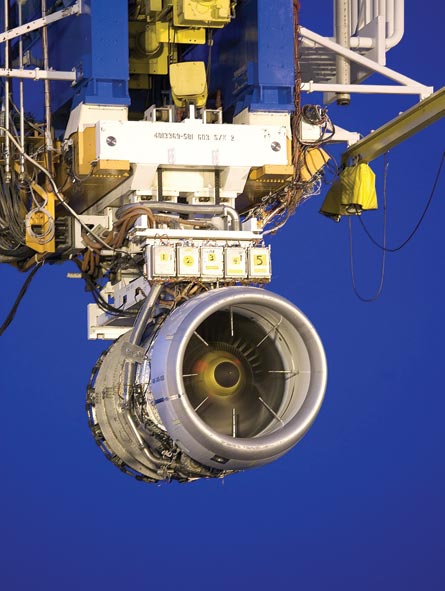China and Russia have their sights firmly set on shaking up the narrowbody market when they launch their respective new single-aisle airliners into service in 2016, a timeline that suppliers to the programmes are confident can be adhered to.
China's Comac C919 and Russia's MS-21 twinjets are both in the joint definition phase, with first flights due to take place in 2014.
United Aircraft (UAC) has secured 190 orders for its planned new MS-21. Comac, on the other hand, has yet to announce a launch customer. Nevertheless, Boeing vice-president marketing Randy Tinseth said earlier this year that the C919 represents "the most direct competitor we've seen" since the US manufacturer swallowed up McDonnell Douglas in 1997.
|
|---|
Composites will account for 40% of the MS-21's structure, but for the time being this does not include the fuselage. "For the fuselage we will use aluminium alloys because we are not ready now to do it with composite materials," UAC president Alexey Fedorov said at July's Farnborough air show. "We do not see any advantages for a fuselage made of composite materials. Maybe some time in the future we will reconsider this and design and produce a composite fuselage also."
The planned production rate for the MS-21 is 70 aircraft annually, or "roughly six airframes per month", says Fedorov. UAC is in the process of establishing a global maintenance network and an after-sales support system. "Before we supply the first aircraft and put it into service, we will prepare our network of support," notes Fedorov.
Irkut has selected two different engines to power the aircraft: the Aviadvigatel PD-14 twin-shaft turbofan and Pratt & Whitney's PurePower PW1400G geared turbofan. For P&W, this represents the beginning of developing a third application for its PurePower GTF. The engine was also selected by Bombardier for the CSeries and by Mitsubishi for the MRJ regional jet.
P&W has been working with Irkut on the engine's joint design phase since last December, a process that will continue through to March 2011. "Early next year we will transition to engine preliminary design," says P&W vice-president next-generation product family Bob Saia. "There will be a six- to eight-month preliminary design phase and then we'll move into the detailed design phase."
The first engine is to start a 22-month test period at the end of 2012, with engine certification expected in mid-2014. "We'll align certification with the aircraft's first flight," says Saia. The planned service entry date for the MS-21 is the first half of 2016.
P&W is exploring the possibility of partnerships with Russian companies to develop the engine for the MS-21. "We've been engaged with Russian companies and we're in the early stages of discussion," says Saia, adding that future collaborations "could include manufacturing and design, but also the services needed after the aircraft is in service". P&W aims to decide on partnerships "some time in 2011".
Saia has been "very impressed with the overall technical expertise and knowledge of the Russian airplane manufacturers", which he sees as a "strong indication that the Russian Federation is focused on revitalising the industry". He adds: "Irkut has selected very strong Western suppliers for the key aircraft systems and the MS-21 will match or exceed some of the Western equipment flying today."
Most of the suppliers for the MS-21 have now been selected. Avionics are being supplied by Rockwell Collins together with Russian partner companies Avionika Concern and Aviapribor, while Hydromash will supply the landing gear. UK firm Meggitt Aircraft Braking Systems has been tentatively selected to provide the braking system and hydraulics will be provided by Eaton. Hamilton Sundstrand has won a number of supplier contracts, including auxiliary power units and wing anti-icing systems, and France's Zodiac Aerospace has also secured several supplier deals.
As Russia ploughs ahead with the MS-21, China's Comac is simultaneously priming its single-aisle competitor, the 150-seat C919, which is also due to take its first flight in 2014 and enter service in 2016. Comac is developing a standard model with a range of 2,200nm and a long-range model capable of flying 3,000nm.
Manufacturing work on sections of the C919's fuselage is under way. Jiangxi Hongdu, an AVIC subsidiary, began work in August on the forward and aft fuselage sections it has been contracted to supply.
The C919 will be powered by CFM International's Leap-X engine. CFM is in the middle of a joint definition phase with Comac, which will continue through until early next year. "There are many technical issues, which is normal for installing a new engine on a new airplane, but we're on track to complete in the first quarter of next year," says CFM Leap programme director Ron Klapproth. "We're building up to the second core engine test in the middle of next year."
CFM aims to carry out the first full engine test in the first quarter of 2013, with engine certification expected in the third quarter of that year. "This will allow Comac to do the first flight and move towards entering service in 2016," says Klapproth.
CFM is exploring the possibility of establishing a final assembly line for engines in China and has signed a memorandum of understanding with China's AVIC Commercial Aircraft Engine Company "to study the feasibility" of pressing ahead with this plan, says Klapproth. "The goal is to have it develop into a final assembly line close to the C919 assembly plant."
|
|---|
A technical review of the C919 is planned for the end of this year and suppliers including CFM and Parker Aerospace - which is providing the hydraulic, fuel and inerting systems - say they are working towards that. Parker vice-president for Asia Pacific says meetings about the technical review are planned in November and December, with completion of the joint definition phase expected by March 2011.
Roger Seager, vice-president and general manager for commercial aircraft programmes at GE Aviation - which has been selected alongside AVIC Systems to provide avionics core processing and on-board maintenance systems for the C919 - says the process is going very well even though Comac has a "very challenging schedule". He adds: "They are absolutely holding to the schedule and, being a brand new company, are learning as they go along."

Rockwell Collins has won three C919 contracts, including the supply of communication, navigation and surveillance equipment and the cabin core system. It has teamed with Shanghai Aero Measurement-Controlling Research Institute (SAMRI) and the UK's Cobham on the CCS deal, with SAMRI agreeing to provide design, development and integration support and Cobham supplying the public address system. Rockwell Collins plans to set up a support service centre in China by the end of this year as part of its strategy to increase its footprint in the Chinese market.
Honeywell has also done well out of the C919, winning contracts to supply the auxiliary power unit, flight controls, wheels and brakes, and inertial reference and air data systems. Interiors are to be supplied by a new Chinese subsidiary of Austrian components manufacturer FACC, while Germany's Liebherr-Aerospace will form a joint venture with AVIC subsidiary Landing-gear Advanced Manufacturing in Changsha to develop, supply and service the landing gear system.
 The challenge now for UAC and Comac is to turn their ambitions into sales. Irkut believes it can win "up to 10% of the world's narrowbody aircraft market". While it has so far secured 190 orders for the MS-21, it has yet to sign up a Western customer. UAC's 20-year business forecast calls for 1,000-1,200 sales, two-thirds of which "will be outside Russia", says Fedorov.
The challenge now for UAC and Comac is to turn their ambitions into sales. Irkut believes it can win "up to 10% of the world's narrowbody aircraft market". While it has so far secured 190 orders for the MS-21, it has yet to sign up a Western customer. UAC's 20-year business forecast calls for 1,000-1,200 sales, two-thirds of which "will be outside Russia", says Fedorov.
Malaysian investment company Crecom Burj became the launch customer for the MS-21 when it placed a firm order for 50 aircraft during the Farnborough air show. Deliveries are expected to begin in 2016 and be completed by 2020. Crecom aims to dry-lease the aircraft throughout South-East Asia.
Irkut has also signed agreements with Russian lessor Ilyushin Finance for 28 MS-21s, with options on an additional 22, and with VEB-Leasing for 15 deliveries and 15 options. Russian carrier Nordwind has signed a letter of intent covering three MS-21s and two options, and Irkut says it has also signed an agreement with an undisclosed carrier for five aircraft. In September, Russian state holding firm Rostekhnologii signed a preliminary agreement for 50 MS-21s, which it expects to firm up by the end of the year.
Comac is not off the starting blocks when it comes to securing customers. However, this year China established its first aviation industry fund aimed at helping local manufacturers market their aircraft to Chinese carriers.
Source: Flight International


















